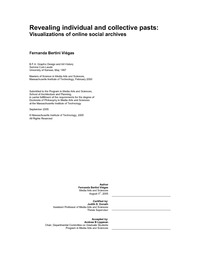Revealing individual and collective pastsVisualizations of online social archives
|

|
 Diese Seite wurde seit 6 Jahren inhaltlich nicht mehr aktualisiert. Unter Umständen ist sie nicht mehr aktuell.
Diese Seite wurde seit 6 Jahren inhaltlich nicht mehr aktualisiert. Unter Umständen ist sie nicht mehr aktuell. Zusammenfassungen
Zusammenfassungen
 The research question I set out to explore was:
Does visualizing the cues & patterns present in social archives help users
understand the spaces they inhabit and the relationships they maintain online?
The research question I set out to explore was:
Does visualizing the cues & patterns present in social archives help users
understand the spaces they inhabit and the relationships they maintain online? The Internet has fostered environments that support social interaction at an unprecedented scale.
Hundreds, thousands of people come together in online public spaces to exchange ideas, ask
questions, and comment on daily life events. A single person can easily stay in touch with several
hundred people all over the globe over email. These public and private exchanges leave behind
massive amounts of persistent traces that are highly representative of the relationships that
people maintain. Yet, these traces are mainly invisible and unusable to users today. In a sense,
this thesis is about making the invisible visible.
The Internet has fostered environments that support social interaction at an unprecedented scale.
Hundreds, thousands of people come together in online public spaces to exchange ideas, ask
questions, and comment on daily life events. A single person can easily stay in touch with several
hundred people all over the globe over email. These public and private exchanges leave behind
massive amounts of persistent traces that are highly representative of the relationships that
people maintain. Yet, these traces are mainly invisible and unusable to users today. In a sense,
this thesis is about making the invisible visible. As mediated communication becomes an increasingly central
part of everyday life, people have started going online to
conduct business, to get emotional support, to find
communities of interest, and to look for potential romantic
partners. Most of these social activities take place primarily
through the exchange of conversational texts that, over time,
accrue into vast archives. As valuable as these collections of
documents may be for our comprehension of the online social
world, they are usually cumbersome, impenetrable records of
the past.
As mediated communication becomes an increasingly central
part of everyday life, people have started going online to
conduct business, to get emotional support, to find
communities of interest, and to look for potential romantic
partners. Most of these social activities take place primarily
through the exchange of conversational texts that, over time,
accrue into vast archives. As valuable as these collections of
documents may be for our comprehension of the online social
world, they are usually cumbersome, impenetrable records of
the past.This thesis posits that history visualization - the visualization of people's past presence and activities in mediated environments - helps users make better sense of the online social spaces they inhabit and the relationships they maintain. Here, a progressive series of experimental visualizations explores different ways in which history may enhance social legibility. The projects visualize the history of people's activities in four different environments: a graphical chat room, a wiki site, Usenet newsgroups, and email. History and the persistent nature of online communication are the common threads connecting these projects. Evaluation of these tools shows that history visualizations can be utilized in a variety of ways, ranging from aids for quicker impression formation and mirrors for self-reflection, to catalysts for storytelling and artifacts for posterity.
 Kapitel
Kapitel 
- 1. Introduction
- 2. Background
- 3. Collective Memories
- 4. Personal Memories
 Diese Doktorarbeit erwähnt ...
Diese Doktorarbeit erwähnt ...
 Diese Doktorarbeit erwähnt vermutlich nicht ...
Diese Doktorarbeit erwähnt vermutlich nicht ... 
 Tagcloud
Tagcloud
 Einträge in Beats Blog
Einträge in Beats Blog
 Volltext dieses Dokuments
Volltext dieses Dokuments
 |  Revealing individual and collective pasts: Gesamtes Buch als Volltext ( Revealing individual and collective pasts: Gesamtes Buch als Volltext ( : :  , 3578 kByte; , 3578 kByte;  : :  2021-03-21) 2021-03-21) |
 Anderswo suchen
Anderswo suchen 
 Beat und diese Dissertation
Beat und diese Dissertation
Beat war Co-Leiter des ICT-Kompetenzzentrums TOP während er diese Dissertation ins Biblionetz aufgenommen hat. Die bisher letzte Bearbeitung erfolgte während seiner Zeit am Institut für Medien und Schule. Beat besitzt kein physisches, aber ein digitales Exemplar. Eine digitale Version ist auf dem Internet verfügbar (s.o.). Es gibt bisher nur wenige Objekte im Biblionetz, die dieses Werk zitieren.









 Chat
Chat E-Mail
E-Mail Internet
Internet Kommunikation
Kommunikation PostHistory
PostHistory Procrastination
Procrastination Raum / Ort
Raum / Ort Usability
Usability Vergangenheit
Vergangenheit Visualisierung
Visualisierung Weblogs
Weblogs Wikipedia
Wikipedia Zeit
Zeit Biblionetz-History
Biblionetz-History